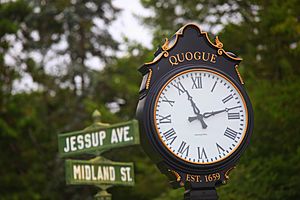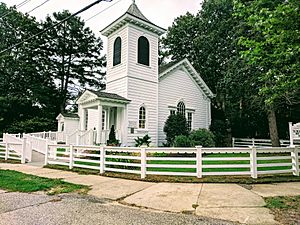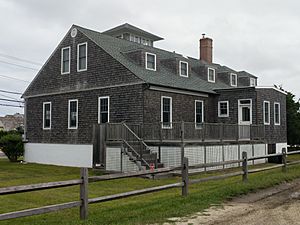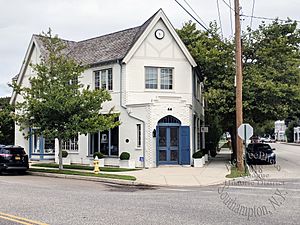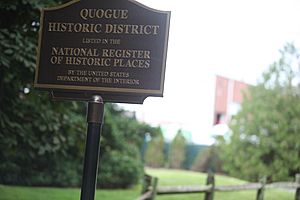Quogue Historic District facts for kids
Quick facts for kids |
|
|
Quogue Historic District
|
|
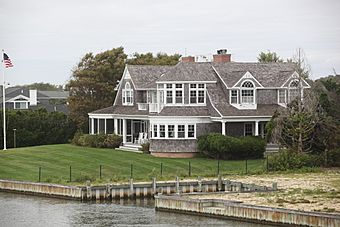
Shingle-style Home on Quogue Canal
|
|
| Location | Quogue St., Quogue, New York |
|---|---|
| Area | more than fifty acres |
| Built | 1659 |
| Architectural style | Shingle Style |
| NRHP reference No. | 15001028 |
| Added to NRHP | Feb 2, 2016 |
The Quogue Historic District is a special area in Quogue, located on the East End of Long Island, New York. This district is full of old homes that have kept their original look and feel. These houses were built in the 1700s, 1800s, and early 1900s. Because of their importance, the district was added to the National Register of Historic Places in 2016. This means it's recognized as a place with a lot of history!
Quogue's Early Days
The story of Quogue began in 1659. A man named John Ogden bought the land, then called Quawcanantucke, from Sachem Wyandanch of the Montauk tribe. He paid 400 pounds for it. The agreement also allowed his friend to still hunt, fish, and gather berries there.
This land, stretching from Westhampton to Southampton, was used for grazing sheep, hogs, and cattle. The very first building was a small shelter for a shepherd. By the mid-1700s, the grandchildren of Southampton's first settlers started the Quogue community. Families like the Cook, Foster, Herrick, Jessup, Howell, and Post families built their homes along Quogue Street.
At first, Quogue was a quiet place with farms by the sea. But by the early 1900s, it became a popular spot for wealthy people. They bought whole farms and built large "cottages" along the sand dunes. Many families who used to stay in boarding houses for the summer decided to build their own homes. They often chose the "shingle-style" design, which uses wooden shingles on the outside. Today, over 250 of these shingle-style homes are part of the historic area.
In 1850, Quogue was part of Southampton Towne. It had the first modern bridge over Quantuck Bay. In 1835, Quogue was the second overnight stop for stagecoaches traveling from Brooklyn to Southampton. This was before the LIRR arrived in Riverhead in 1844. During the Victorian era, many people rushed to build homes in the Hamptons.
Steamships sailed along the Atlantic coast. Homes built by whalers were common on Quogue and Quaquanantuck streets. Jessup Avenue became the main street for businesses. A country market and the fire department were set up there in 1870. Early important buildings included a linen house and a store by the pond, which is now home to the Quogue Historical Society. Quogue Street, the widest street in the village, was once a path where cattle were herded each spring.
By 1845, whaling was a huge business in the country. People needed whale oil for lighting, making it very valuable. In Quogue, some families put money into whaling trips. Others joined the whaling crews. A good number even became captains of their own whaling ships.
Some of these captains included Frederick M. Hallock, Henry Gardiner, Edward Stevens, and members of the Cooper family.
Before this, Quogue was a peaceful farming community. Each small farm grew food. People also worked by farming, fishing in the ocean, and then whaling. They started with small whaleboats from the shore. Later, they used larger ships like Barks and Schooners for long ocean trips. By 1855, a new business was growing: hosting summer visitors in boarding houses.
In 1870, a train line (a "spur" of the LIRR) reached Quogue. This brought many visitors each summer. By 1880, Quogue was a busy summer resort. There were thirteen boarding houses and hotels along Quogue Street, and the village thrived. The cottages on Dune Road were large, built to hold all the beachgoers. At this time, Quogue was thought to be the wealthiest village on Long Island, based on how many rich residents it had. The LIRR even nicknamed it "The Queen of the Hamptons."
Facing Ocean Storms
Out at sea, powerful storms called "nor'easters" were very dangerous. But thousands of people also lost their lives to the sea right near the shore. In the mid-1800s, there was a small building among the sand dunes. This was the first shed used by the Quogue Life-Saving Station. This station helped rescue people from shipwrecks.
In 1872, the station got a bigger, red house. This red house is still on Dune Road today, but it's a private home. The original shed was used from 1849 to 1872. Many shipwrecks happened during this time. The famous poet Longfellow wrote about a terrible winter storm and shipwreck in 1839. Long Island had many such wrecks. This showed the need for people to watch the coast and for rescue boats.
Life-saving stations were built along the south shore. Shipwrecks like the "Infanti" (1851), the "Europa" (1886), and the Nahum Chapin (1898) made the Quogue life-saving station well-known. In 1915, it became part of the U.S. Coast Guard.
The newest station building, designed in 1912, is one of the few examples of this type of building left. It was the only individual building in the Quogue Historic District listed on the National Register of Historic Places, even though it was just outside the district's main area.
Why Quogue is Historic
Nancy D. Mullan of Quogue was very important in making the Quogue Historic District happen. She was on the Town of Southampton Landmarks and Historic Districts Board and also part of the Quogue Historic Preservation Society. Thanks to her efforts, the district was added to the New York State Register in December 2015. Then, it was added to the National Register on February 2, 2016.
Places like the Quogue Community Hall on Jessup Avenue and the Hampton Theatre Company are part of the historic district. St. Paul AME Zion Church on Montauk Highway is also a Southampton town landmark. People had been trying to get the hamlet recognized as historic since 1992. Many attempts were turned down because some wondered if the areas really had enough historical importance.
The Village of Quogue was different from other Hamptons towns. It had a charming country village feel, without as much of the "moneyed" (very rich) elements found further east. Starting in the 1840s, visitors stayed in rooming houses for about four months each year. Grand cottages lined Dune Road. The connection to whaling captains from Sag Harbor, the landmarked Life-Saving Station, and the many Victorian-era homes still standing eventually helped Quogue gain its historic status. Over 200 Victorian-era houses help make the district historic.
The National Park Service, when approving the district, said that the Quogue Historic District is important for its history of settlement, social life, and recreation. It's also important for its amazing collection of buildings. These buildings show how Quogue changed from an early farming community into a place mainly for summer visitors in the 1800s. Many Victorian homes are still standing in the Quogue Historic District. More than 300 acres of land have been set aside as a wildlife refuge. Historic Victorian summer cottages and modern mansions line Dune Road. Many homes on the village streets have the wrap-around porches that were popular at the time. The Life-Saving Station and the Quogue Cemetery are already listed separately on the National Register of Historic Places.
The golf course at the Quogue Field Club, designed by Tom Bendelow, is also considered an important part of the district's recreational history.
Five houses are the oldest in the village: First House, Old Revolution, Antiquity, the Miss Mary Post House, and the Foster Homestead. All of these homes date back to before the Colonial era. While their outsides are historic, their interiors have been updated over time.
Images for kids




